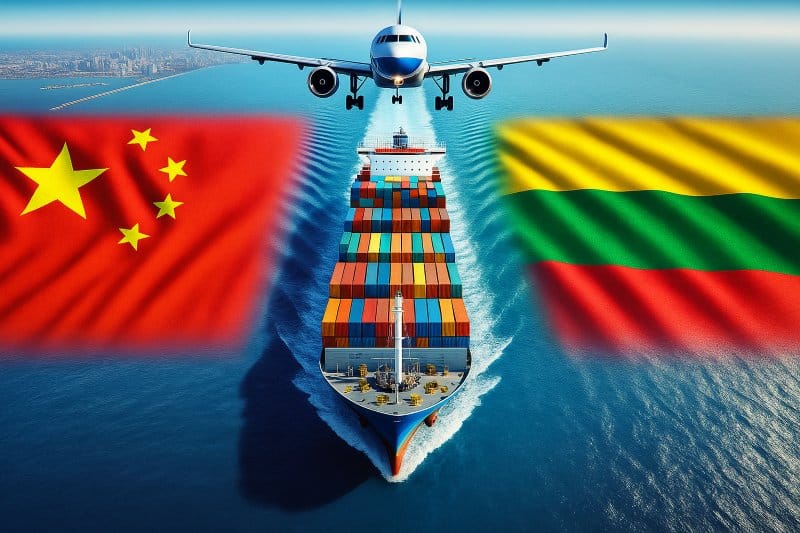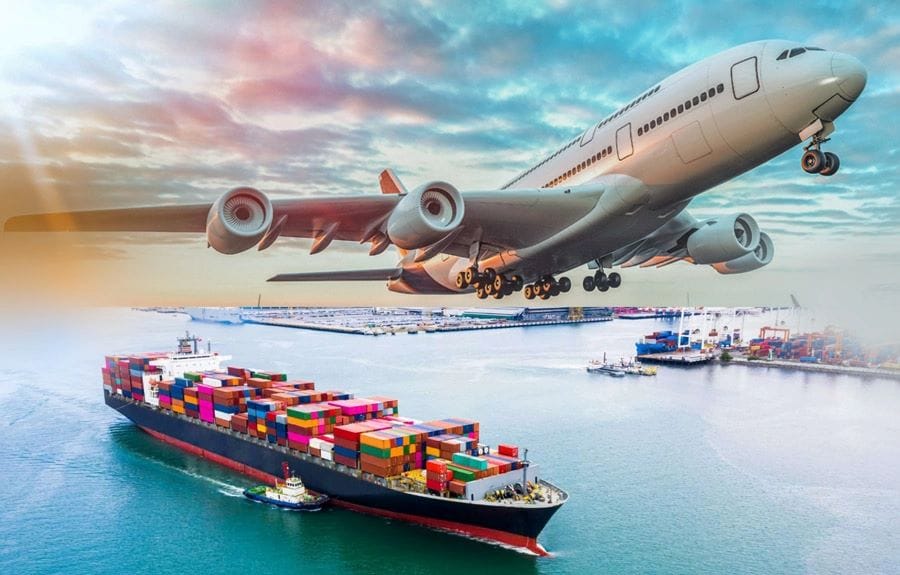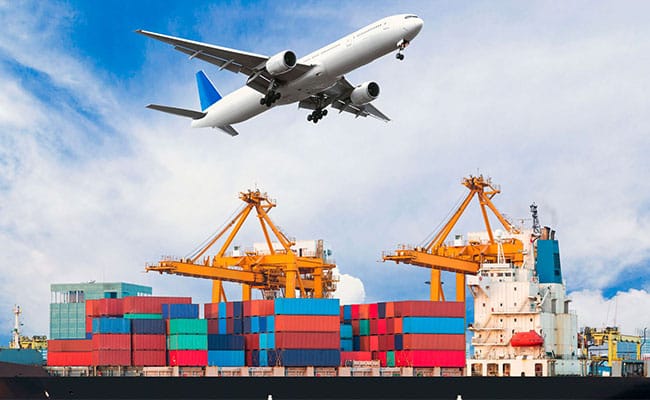With the growing trade between China and European countries, Lithuania, as one of the three Baltic countries, is a hub connecting Northern Europe, Eastern Europe and Western Europe, and is gradually becoming an important springboard for Chinese companies to enter the European market. This article will introduce the logistics from China to Lithuania in detail.
Learn more: Shipping from China to Latvia

Shipping Methods from China to Lithuania
The transportation methods from China to Lithuania are constantly being optimized. According to the nature of the goods, delivery requirements and transportation budget, different logistics solutions can be flexibly selected, mainly including sea transportation, air transportation and China-Europe trains.
Sea Freight
Sea transportation is the lowest-cost international transportation method, suitable for large quantities and non-urgent goods. A variety of goods can be transported. For products such as furniture, machinery, and building materials, there are mainly two types of service types: full container (FCL) or less than container (LCL).
Main ports:
- Klaipeda Port: It is the largest seaport on the east coast of Lithuania, located in the Lithuanian … The port terminal is located in the Klaipeda district and is the main cargo and passenger handling facility in Lithuania, handling about 80% of the country’s trade volume.
- Klaipeda Port: It is the largest seaport on the east coast of Lithuania, with an annual cargo throughput of more than 40 million tons. The port terminal is located in the Klaipeda district and is the main cargo and passenger handling facility in Lithuania, handling about 80% of the country’s trade volume.
| Service | Cost | Transit Time | Best For |
|---|---|---|---|
| LCL Shipping | $280 per m³ | 35–50 days | Small shipments sharing container space. |
| FCL Shipping (20′) | $3,700 | 35–45 days | Medium-sized shipments requiring dedicated space. |
| FCL Shipping (40′) | $6,500 | 35–45 days | Bulk goods needing cost-effective transport. |
Air Freight
Air freight can deliver your goods quickly and safely, and is suitable for goods with high time or safety requirements such as electronic products, samples, and luxury goods. Customs clearance is easy and can be cleared quickly, but the freight is high and there are more restrictions on the size/weight of the goods.
Major airports:
- Vilnius International Airport: It is the largest airport in the country and the main gateway for air import and export of goods. It has international cargo routes and supports global freight companies such as DHL, UPS, and FedEx. It has complete infrastructure and has cold chain and high-value cargo storage capabilities.
- Palanga International Airport: Located in Vilnius, the capital of Lithuania. It is the second largest airport in the Baltic region, one of the largest and busiest airports in Lithuania, and a major transportation hub in Lithuania, providing flights to all parts of the world.
| Service | Cost | Transit Time | Best For |
|---|---|---|---|
| Air Freight | $10.5 per kg | 5 to 8 days | Electronics, pharmaceuticals, luxury goods, and urgent deliveries. |
Rail Freight
As an important logistics method under the “Belt and Road” initiative in recent years, the China-Europe Express has become increasingly mature in railway transportation connecting China and Lithuania. The time efficiency is between air and sea transportation, the price is moderate, the stability is strong, it supports full container and LCL, and it is environmentally friendly and efficient
Major railway hubs:
- Vilnius: National Railway Transportation Dispatching Center, also the main distribution point of China-Europe Express, part of the EU railway transportation network, with good cross-border coordination capabilities.
| Service | Cost | Transit Time | Best For |
|---|---|---|---|
| 20-foot container | $3,500 | 18–22 days | Medium-volume goods needing timely delivery. |
| 40-foot container | $6,200 | 18–22 days | Bulk goods requiring a balance of speed and cost. |
Shipping Cost from China to Lithuania
The cost of shipping from China to Lithuania depends on the mode of transport, but is also affected by a variety of factors, including the following:
- Fuel Costs: International shipping costs change frequently. Therefore, the quotes for the same quantity of goods will not be the same.
- Weather: No matter what mode of transport you use, bad weather will not only affect the shipping time, but also the shipping cost.
- Distance: This is probably the most important reason for the variation in shipping costs.
- Weight and Size: The larger and heavier the package, the higher the shipping cost. Therefore, try to choose small packages to reduce shipping costs.
- Customs: Each country has different policies on tariffs, VAT and other taxes for different products. You should understand the tariffs and other fees before shipping so that you can make accurate calculations.
- Insurance: Although it is not mandatory, if you purchase insurance, the shipping cost will increase.
- Delivery Surcharge: This fee applies to express services. The specific amount depends on your delivery and delivery locations.
Here is a detailed breakdown of average costs:
| Shipping Mode | Cost | Key Features |
|---|---|---|
| LCL (Less Container Load) | $280 per m³ | Ideal for small shipments consolidated into shared containers. |
| FCL (20-foot container) | $3,700 | Suitable for medium-sized shipments requiring dedicated space. |
| FCL (40-foot container) | $6,500 | Cost-effective for bulk shipments with large volumes. |
| Rail Freight (20-foot) | $3,500 | Faster than sea freight and suitable for medium-volume shipments. |
| Rail Freight (40-foot) | $6,200 | Balances cost and speed, with direct routes to European hubs. |
| Air Freight | $10.5 per kg | Recommended for high-value or time-sensitive goods. |

Import Taxes and Duties in Lithuania
Tariffs are an important expense in the entire shipping process. Knowing them helps estimate shipping costs. As a member of the European Union, Lithuania adheres to the EU’s customs framework. This means that all goods imported from China are subject to value-added tax (VAT) and tariffs. The standard VAT rate in Lithuania is 21%, which is applied to the total value of the goods, shipping costs, and applicable tariffs.
| Product | Customs Duty Rate | VAT Rate | Examples |
|---|---|---|---|
| Electronics | 0% to 5% | 21% | Smartphones, computers, and appliances. |
| Clothing | 10% | 21% | Apparel, fabrics, and textiles. |
| Footwear | 12% | 21% | Shoes, boots, and accessories. |
| Toys | 4.7% | 21% | Children’s toys and board games. |
| Machinery | 2% | 21% | Industrial and manufacturing equipment. |
How to Reduce of Shipping Cost from China to Lithuania?
International trade can only be profitable if you know how to minimize import costs and source products from quality suppliers. Here are some important tips you can follow when shipping goods from China to Lithuania to reasonably reduce shipping costs:
- Pack items carefully and keep package sizes small. Don’t pack too large and divide them into smaller packages.
- Choose the mode of shipping wisely. Sometimes air freight is cheaper than sea freight. Ask for expert advice from your freight forwarder.
- Choose two ports that are close to each other to reduce shipping costs.
- For regular items, don’t buy insurance. If you buy insurance, use a third-party insurance company.
- Look for a freight forwarder that offers extra benefits.
- Request quotes from different freight forwarders and choose the best one with the lowest price.
- If the price is too low, check if there are any hidden fees.
Shipping Time from China to Lithuania
Shipping time from China to Lithuania depends on the mode of transport you choose and is also affected by the following delivery times
- Port distance: Ocean freight usually arrives at the port of Klaipeda, the main shipping hub in Lithuania.
- Customs efficiency: Lithuania’s modern customs system ensures smooth processing, but incomplete documents may cause delays.
- Seafood demand: Transportation volume reaches a peak during holidays, which may cause congestion at ports or along railways.
Full Container Load (LCL)
It takes about 30-40 days from a coastal port in China to the port of Klaipeda, and the total time for customs clearance and delivery is about 45 days.
Less Than Container Load(FCL)
It is relatively faster and can be controlled within about 30 days.
Railway Freight (China-Europe Express)
It starts from Yiwu/Chengdu/Chongqing and is transferred to Lithuania via Poland, with a total journey of 15-20 days.
Air Freight
If you fly directly from Guangzhou/Shanghai to Vilnius Airport, it can be completed in 3-5 days at the fastest, and it can be completed in about 5-7 days after customs clearance and delivery.
| Shipping Mode | Transit Time | Best Suited For |
|---|---|---|
| Sea Freight | 35 to 50 days | Cost-sensitive bulk shipments with flexible timelines. |
| Rail Freight | 18 to 22 days | Medium-sized shipments requiring faster delivery. |
| Air Freight | 5 to 8 days | High-value or time-sensitive goods. |
Detailed Process of Shipping from China to Lithuania
The following is a complete process analysis of transport services from China to Lithuania, applicable to various modes such as sea, rail, and air transport. This process can help you clearly understand every link.
Confirm order and logistics plan
The customer provides cargo information (cargo name, packaging method, volume/weight, shipping address), and the freight forwarder recommends the best transportation method and determines the quotation plan based on the characteristics of the cargo and customer needs.
Sign a transportation entrustment agreement
Communicate as soon as possible, especially if there is a DDP requirement, the recipient’s tax number, importer information, etc. should be provided.
Door-to-door pickup (within China)
The freight forwarder arranges a truck to pick up the goods at the factory, warehouse or designated location, and provides a bill of lading and a list of goods.
Export customs declaration (Chinese port)
Freight forwarder prepares export customs declaration materials on behalf of you:
- Commercial invoice
- Packing list
- Export contract (if any)
- Product compliance certificate (such as CE, MSDS, etc.)
International transportation (sea/rail/air)
Transport from China to Lithuania by appropriate transportation methods. Freight forwarders usually provide real-time tracking system or track update service.
Customs clearance in the country of destination (Lithuania)
- DDP service: The freight forwarder bears the customs duties and VAT, and customers do not need to bear the cumbersome customs clearance process
- DDU service: Customers pay customs duties and VAT by themselves, and freight forwarders provide assistance
Final delivery (within Lithuania)
After customs clearance, the goods are delivered to the buyer’s address by local express/logistics
Freight Forwarder from China to Lithuania
Freight forwarders are essential to ensure smooth transportation of goods from China to Lithuania. They are responsible for coordinating the entire logistics process, including route optimization, customs clearance, and cargo tracking.

Main responsibilities of a freight forwarder:
- Customs expertise: Ensure compliance with EU regulations and handle all required documentation.
- Route optimization: Select the most efficient and cost-effective routes to minimize shipping time and costs.
- Cargo insurance: Protect cargo from potential damage or loss during transportation.
- Real-time tracking: Provides visibility into the status of shipments, enabling proactive management of any issues.
When choosing a freight forwarder, consider the following factors:
- Experience: Choose a company with a proven track record on the China-Europe trade route.
- Network coverage: Make sure the freight forwarder has strong connections to major European logistics hubs, such as the Port of Klaipeda or Vilnius.
- Service offerings: Look for a provider that offers comprehensive solutions, including multimodal transport and warehousing.
Shipping from China to Lithuania is an important logistics chain connecting East Asia and Europe. By choosing the right mode of transportation, scientifically planning costs, avoiding risks, and choosing an experienced freight forwarding company, you can greatly improve transportation efficiency and reduce costs.
